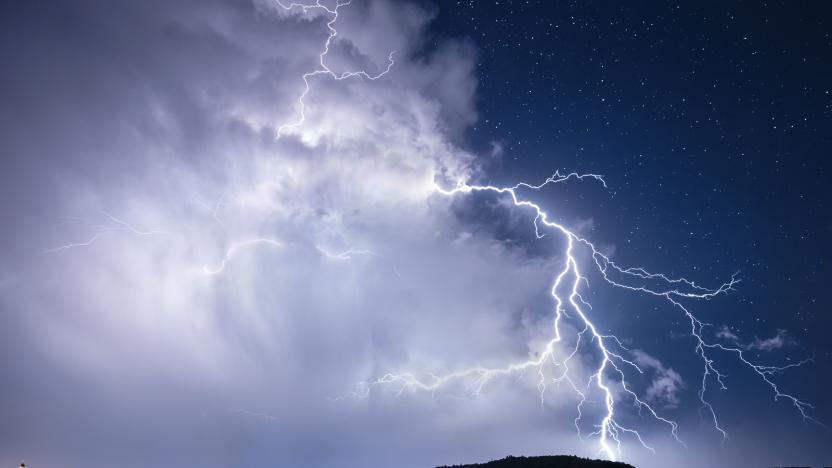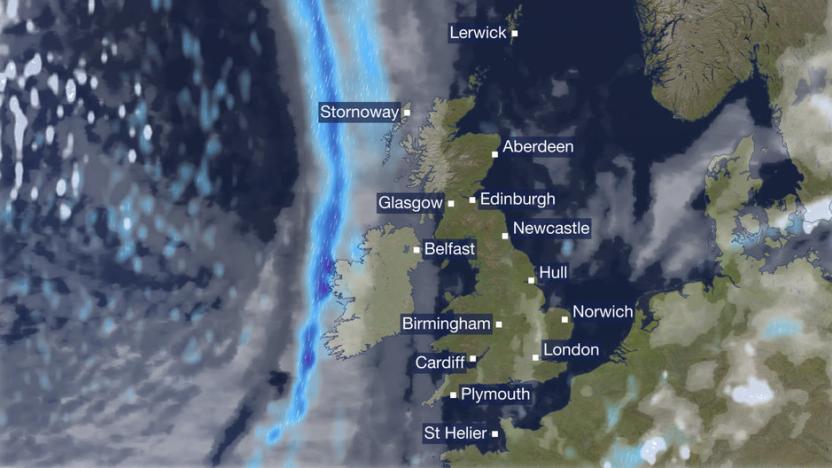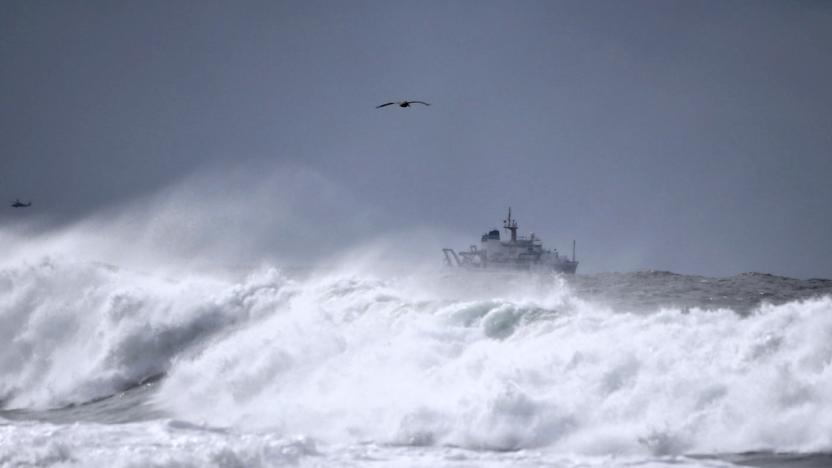WeatherForecast
Latest

IBM is turning to your smartphone to improve weather forecasts
IBM and its subsidiary The Weather Company are working on a new weather forecasting system, one that they say will boost forecast accuracy quite a bit. It's called the Global High-Resolution Atmospheric Forecasting System, or GRAF, and it will pull data from weather stations, aircraft sensors and smartphone pressure sensors -- a massive amount of information that will be analyzed by the IBM technology that powers the US Department of Energy's powerful Summit and Sierra supercomputers.

People aren’t happy with the BBC’s big weather redesign
Today, the BBC is launching a major redesign of its popular weather forecast services — and some Brits are furious. It all started in 2015 when the broadcaster announced it was ditching the Met Office and looking for a new provider of accurate weather data. MeteoGroup was eventually crowned the winner and work began to overhaul the technical architecture underpinning the BBC's much-loved TV bulletins, mobile apps and website. The new web and mobile designs were rolled out to "some users" last month and the reaction was overwhelmingly negative. On a blog post written by the BBC's Michael Burnett, one user commented: "You seemed to have ruined what was a superb site with a wealth of information."

Facebook puts a weather section in its mobile apps
Facebook aims to offer almost everything you'll want to have on a phone: games, video and photo filters, chat apps, shopping portals and now even week-long weather forecasts. The social network has rolled out a full-fledged weather section right within its mobile apps, and a spokesperson told TechCrunch that around 95 percent of users around the globe should already have access to it.

Ocean waves and temperatures can predict extreme summer heat
Predicting the weather typically caps out around 10 days in advance for certain factors, but a new study could extend that up to almost two months. By measuring the surface temperature of oceans from 1982 to 2015, specifically in 2012, The New York Times writes that a team of researchers (PDF) noticed correlations between a pair of precursors leading to hotter days in parts of North America: precipitation deficits and "anomalous atmospheric wave trains." The former is pretty easy to understand. The latter, standard parts of atmospheric flow caused by wind, are abnormal patterns of crests and troughs leading to shore.

ICYMI: Weather in a box, cyborg drummer and more
#fivemin-widget-blogsmith-image-596751{display:none;} .cke_show_borders #fivemin-widget-blogsmith-image-596751, #postcontentcontainer #fivemin-widget-blogsmith-image-596751{width:570px;display:block;} try{document.getElementById("fivemin-widget-blogsmith-image-596751").style.display="none";}catch(e){}Today on In Case You Missed It: The world's biggest 3D printer was just unveiled in Italy and it's a hefty 40 feet tall and 20 feet in diameter, earning its name, "Big Delta." Its intended purpose is to build mud huts for emergency housing. A device called the Tempescope can be synced with an app in your home and actual rain or show condensation for fog, depending on the day's weather forecast. And a drummer who lost his right arm is back in the game, fiercer than before, with help from a robotics professor.

BBC to stop using Met Office weather data after 93 years
For almost a century, the Met Office has supplied the BBC with weather data for its daily forecasts. Its predictions aren't always correct, and they're often a depressing end to TV news bulletins, but they hold an important role in British culture. Until now, that is. The BBC says it's looking for an alternative provider "to make sure we secure both the best possible service and value for money." The Met Office, an executive agency under the UK's Department for Business, Innovation and Skills, has called the news "disappointing."

Ballpark Weather for iPhone is handy and timely
What could be more helpful during baseball season than a weather app aimed at conditions around your local ballpark? Ballpark Weather comes to the rescue with all sorts of helpful information to make game day more enjoyable and help you prepare when Mother Nature throws you a curve. Ballpark Weather is based on information from the highly regarded Rain Aware app. There's a wealth of information within the app. You can look around the National and American Leagues and see where it's raining and when it will stop. There's also radar images, wind and sunset times, extended forecasts and more. You can even save your favorite teams for quick access. %Gallery-186165% This is the kind of app a baseball fan will love. Everything loads quickly, and I didn't have any unpleasant surprises using it. Ballpark Weather is very worthwhile for $0.99. While you can get some of the weather information from other apps, the targeted baseball information is extremely useful. Ballpark Weather is an iPhone app, but it looks OK enlarged on the iPad. The app is optimized for the iPhone 5 and requires iOS 4.3 or later.

NASA accidentally improves weather forecasting with lunar dust-measuring lasers
Anyone that's ever tried to plan an outdoor activity in advance knows that weather forecasting is not an exact science, but the perpetual sky-watchers at NASA may have inadvertently found a way to improve these guesstimations. They have been testing a laser system for measuring lunar dust and soil kicked up by rocket exhausts, and while using precipitation as a substitute to calibrate the laser, they found they could measure the average size of raindrops passing through it. This value is estimated in current forecasting models, so plugging in some accurate numbers should make those predictions more reliable. The original mission hasn't been forgotten, though. Particles whipped up by landing rockets on the moon's surface could damage what was left behind by the Apollo missions, ruining its scientific and historic value. One of the laser sensors may find its way onto a craft vying for Google's X Prize, with the results used to determine where vessels can touch down whilst keeping a safe distance from Apollo landing sites. Although an accidental discovery, the system's other potential career in weather forecasting will also continue to be explored. Now, if only there was a way to make it rain and speed up the testing.

Daily iPhone App: Weathercube is an interesting but eccentric iOS app
Weathercube is an interesting and graphically pleasing approach to giving you the weather on your iPhone or iPod touch. It is not universal, but will run on an iPad in 2x mode. It sells for US$1.99. Weathercube supports several gestures which will get you to extended forecasts, other pre-set cities and even the settings. It provides a lot of information, and swiping the screen gets you a slick animation that looks like the cube is turning in perspective. If you look at the app icon you can get an idea of the animation effect. %Gallery-164565% Where the app fails is displaying the information in an easily accessible format. Here's an example. When you open the app you are presented with sky conditions, temperature, wind speed and barometer reading. At the bottom of the screen, two percentages are displayed. Why two? Because one is cloud cover, the other is humidity, but they are not labelled. Same with temperature. On the home screen, you get a high temperature prediction, not the current temperature. It's all a bit confusing. If you want the current temperature you need to swipe down for the hourly temperatures, and the current conditions will be at the top. Worse, next to the predicted hourly temperatures is the predicted barometric temperature, which is I think the last thing you would want in a prediction. How about wind speed or humidity? The app allows you to select background colors to personalize the look of the screens, but with some combinations it is hard to read the labels. Sounds accompany most gestures on the app. I found them distracting, but happily they can be turned off. These issues can be easily fixed, and if they are, Weathercube will be vastly improved. The display is minimalist, but you can dig pretty deep with gestures. Switching to other cities is easy, and the database has more than 1.7 million locations. The app is also multi-lingual, with support for Chinese, Dutch, French, German, Italian, Japanese, Spanish and more. I like the idea behind the app, I just think more labels, current conditions moved to the home screen and being careful about the colors obscuring the text would go a long way to make the presentation a success. Weathercube requires iOS 4.3 or later and it's a 9.8 MB download. Some screenshots are below.

Google adds browser-based weather feature to tablets with temperature, wind and precipitation
You may have noticed Google's forecast feature on your HTML5-capable smartphone browser -- simply typing "weather" into the search field brings up a basic real-time temperature tool, complete with hourly and five-day forecasts for your current location. That feature has been around in one form or another since the beginning of last year, but as of this week, it's made its way to tablets, too. Web weather is entirely browser based, and you can bring it up in just the same way as on a smartphone -- confirm that your GPS is enabled, then head to Google.com and type "weather" -- you'll be rewarded with a 10-day forecast, complete with temp, precipitation, humidity and wind speed readouts. The tool is interactive, so while you may only be able to view a few days of weather at once, you can simply slide along the timeline to see more. The same applies to the hourly forecast as well. There's nothing to download or subscribe to for this one, and it's available right now at Google.com. James Trew contributed to this report.

Cryoscope gadget simulates tomorrow's weather today (video)
This multi-layered device can't shower you with hail or tan your outdoor-deprived complexion, regrettably. What it can do though, is deliver a direct haptic sensation of how warm or cold it'll be tomorrow, just in case you decide to venture out of your bedroom. An Arduino controller pulls in forecast data from the web and uses it to adjust a Peltier element and a cooling fan, which are housed along with a heat sink inside a neat and tactile aluminum box. The Cryoscope is the handiwork of industrial design student Robb Godshaw, and it's the reason he already knew he'd be wearing a skinny t-shirt and stripey socks in the video after the break.

Oregon Scientific Time & Wireless Charging Stations hands-on
Buried within the pile of gadgets at Oregon Scientific's CES booth were these two Time & Wireless Charging Stations. On the left we have the entry-level clock that's already out in the market, whereas the bigger "plus" model on the right made its debut at the show, boasting the extra clock projection and weather forecast feature. Also shown along side were the customized iPhone 4 Qi sleeves that Oregon Scientific will be offering online, and they actually had pretty high quality finish, too, especially with the texture coating on top of them. Do take a closer look in our hands-on photos below.

Arduino kit beams low-fi Google Weather to VGA screens
Looking for another way to use that aging VGA CRT screen hogging space in the closet? Try making your own dedicated weather screen by mixing together Google's meteorological data stream and some Arduino magic. It looks like parsing that Google Weather data was a bit of a challenge on the miniscule 2KB of RAM, but a tinkerer going by the handle Zmashiah has managed to do it. He's even managed to cram in a few extra graphical flourishes, including icons and background themes that change depending on the temperature and time of day. The entirely PC-free device grabs the data through an Ethernet connection and flashes up all the weather goodness in stunning VGA. Any meteorological mavens reading this can grab the full shopping list and procedure at the Instructables link below.









